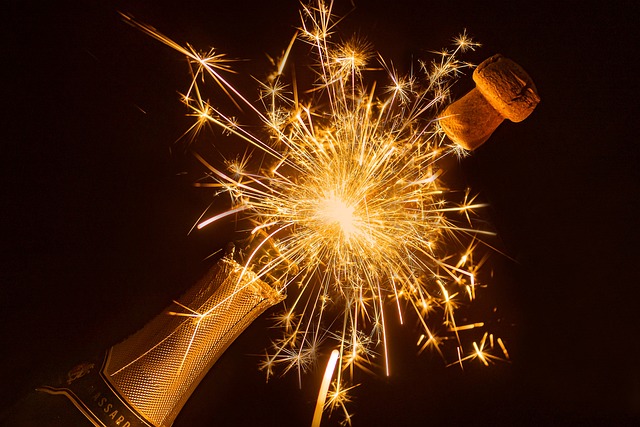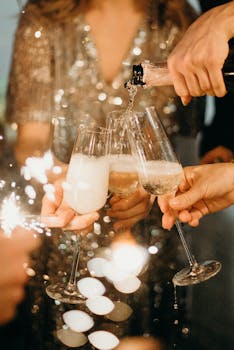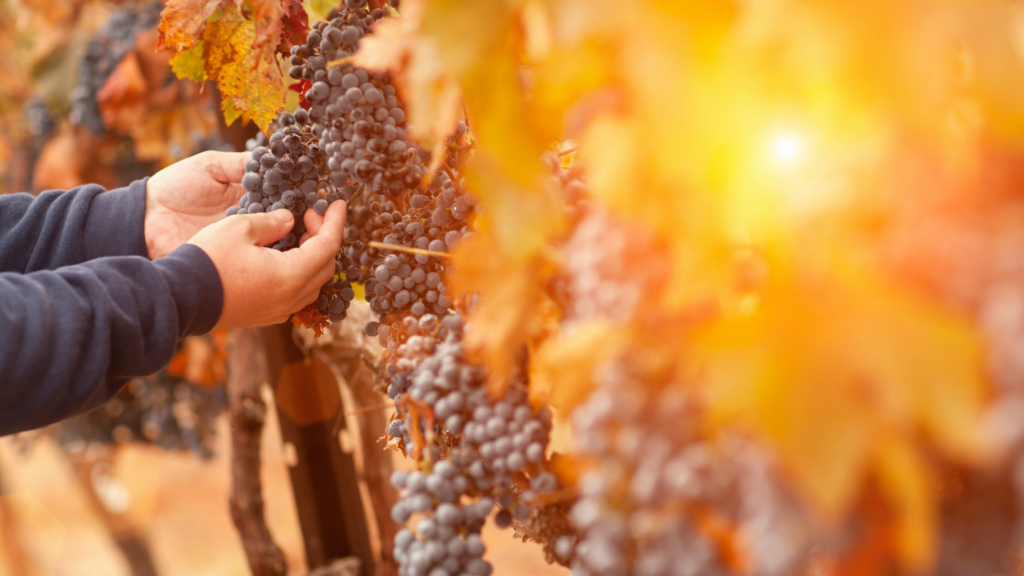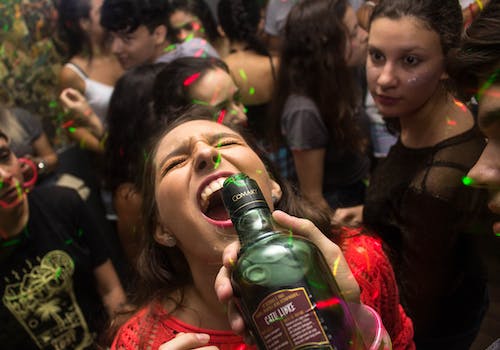-
Table of Contents
- The History and Tradition of Champagne: A Sparkling Journey
- Choosing the Perfect Champagne for Your Festive Celebrations
- Champagne Cocktails to Elevate Your Holiday Parties
- Exploring the Different Champagne Regions and Their Unique Flavors
- Pairing Champagne with Festive Foods: A Guide to Culinary Delights
- Hosting a Champagne Tasting Party: Tips and Ideas for a Memorable Event
- The Art of Champagne Sabering: Adding a Touch of Drama to Your Celebrations
- Champagne Gift Ideas: Thoughtful Presents for Champagne Lovers
- Creating Festive Champagne-inspired Cocktails at Home
- Q&A
“Toast to Joy: Celebrate the Festive Season with Champagne!”
Introduction: Celebrate the Festive Season with Champagne
Champagne, the sparkling wine synonymous with celebration and luxury, is the perfect companion to elevate your festive season. Whether it’s a holiday gathering, a New Year’s Eve party, or a special occasion, Champagne adds a touch of elegance and effervescence to any event. With its distinctive bubbles, crisp flavors, and rich history, Champagne has become a symbol of joy and merriment. So, raise your glasses and toast to the festive season with this iconic beverage that embodies the spirit of celebration.
The History and Tradition of Champagne: A Sparkling Journey
The festive season is a time of joy and celebration, and what better way to mark the occasion than with a glass of champagne? This sparkling wine has long been associated with special occasions and is a symbol of luxury and elegance. But have you ever wondered about the history and tradition behind this iconic drink? Join us on a sparkling journey as we explore the fascinating world of champagne.
Champagne, as we know it today, has its roots in the Champagne region of France. The unique climate and soil of this region create the perfect conditions for growing grapes that are used to make this exquisite wine. The history of champagne dates back to the 17th century when the Benedictine monk Dom Pérignon is said to have discovered the method for making sparkling wine. While the exact details of this discovery are shrouded in mystery, it is widely believed that Dom Pérignon was instrumental in perfecting the techniques that are still used today.
The production of champagne is a labor-intensive process that requires great skill and precision. The grapes used to make champagne are harvested by hand and then carefully pressed to extract the juice. This juice is then fermented in stainless steel tanks or oak barrels, where it undergoes a second fermentation process. It is during this second fermentation that the bubbles are created, giving champagne its signature effervescence.
After the second fermentation, the wine is aged in the bottle for a minimum of 15 months, although some champagnes are aged for much longer. This aging process allows the flavors and aromas to develop, resulting in a complex and well-balanced wine. The bottles are stored horizontally in underground cellars, where they are protected from light and temperature fluctuations.
One of the most important aspects of champagne production is the blending process. Champagne is typically made from a blend of different grape varieties, including Chardonnay, Pinot Noir, and Pinot Meunier. Each grape variety brings its own unique characteristics to the final blend, creating a harmonious and well-rounded wine. The art of blending is a skill that has been passed down through generations of winemakers, and it is this expertise that sets champagne apart from other sparkling wines.
In addition to its rich history and tradition, champagne is also steeped in symbolism and ritual. Opening a bottle of champagne is an event in itself, with the distinctive pop of the cork signaling the start of a celebration. The pouring of champagne into flutes is done with great care, as the bubbles are delicate and should be preserved for as long as possible. The clinking of glasses and the toasting of friends and loved ones are all part of the champagne experience, adding to the sense of occasion and camaraderie.
So, as you raise a glass of champagne this festive season, take a moment to appreciate the history and tradition behind this iconic drink. From its humble beginnings in the Champagne region of France to its status as a symbol of luxury and celebration, champagne has truly stood the test of time. Whether you are celebrating a special occasion or simply enjoying a moment of indulgence, champagne is the perfect companion for any festive gathering. Cheers to the sparkling journey of champagne!
Choosing the Perfect Champagne for Your Festive Celebrations
The festive season is a time of joy and celebration, and what better way to toast to the occasion than with a glass of champagne? Champagne has long been associated with special occasions and is the perfect drink to add a touch of elegance and sophistication to any festive gathering. However, with so many different types and brands of champagne available, choosing the perfect one for your celebrations can be a daunting task. In this article, we will guide you through the process of selecting the ideal champagne to make your festive season truly memorable.
When it comes to choosing champagne, one of the first things to consider is your budget. Champagne can range in price from affordable options to extravagant bottles that will leave a dent in your wallet. It’s important to set a budget and stick to it, as there are plenty of excellent champagnes available at various price points. Remember, the price of champagne is often reflective of its quality, but that doesn’t mean you can’t find a great bottle within your budget.
Next, consider the style of champagne that you prefer. Champagne can be categorized into three main styles: non-vintage, vintage, and prestige cuvée. Non-vintage champagne is a blend of wines from different years and is the most common style available. It offers a consistent taste and is a great choice for those who enjoy a classic champagne flavor. Vintage champagne, on the other hand, is made from grapes harvested in a single year and is aged for a longer period. It tends to have a more complex and nuanced flavor profile, making it a favorite among connoisseurs. Lastly, prestige cuvée champagne is the crème de la crème of the champagne world. It is made from the best grapes and is often produced in limited quantities. This style of champagne is perfect for those looking to indulge in the finest bubbly.
Another important factor to consider when choosing champagne is the sweetness level. Champagne can range from bone dry to very sweet, and the sweetness level is indicated by the terms “brut,” “extra brut,” “extra dry,” “sec,” “demi-sec,” and “doux.” Brut champagne is the driest and most popular style, with a crisp and refreshing taste. Extra brut is even drier, while extra dry is slightly sweeter. Sec, demi-sec, and doux champagnes are progressively sweeter, with doux being the sweetest. Consider your personal preference and the taste preferences of your guests when selecting the sweetness level of your champagne.
Lastly, don’t forget to consider the food pairings for your festive celebrations. Champagne is a versatile drink that pairs well with a variety of dishes. For a classic pairing, opt for a brut champagne to complement seafood, oysters, or caviar. If you’re serving a rich and flavorful main course, a vintage champagne with its complex flavors will be a great match. For dessert, consider a sweeter champagne like demi-sec or doux to complement sweet treats such as fruit tarts or chocolate desserts.
In conclusion, choosing the perfect champagne for your festive celebrations is a matter of personal preference and budget. Consider your budget, the style of champagne you prefer, the sweetness level, and the food pairings to find the ideal bottle for your celebrations. Remember, champagne is not just a drink, but a symbol of celebration and joy. So raise your glass and toast to a festive season filled with happiness and cheer!
Champagne Cocktails to Elevate Your Holiday Parties
The festive season is upon us, and what better way to celebrate than with a glass of champagne? This sparkling wine has long been associated with special occasions and is the perfect choice to elevate your holiday parties. But why settle for a plain glass of bubbly when you can create champagne cocktails that will truly impress your guests?
One classic champagne cocktail that never fails to delight is the Bellini. This elegant drink originated in Venice and is made by combining peach puree with champagne. The result is a refreshing and fruity concoction that is sure to please even the most discerning palates. To make a Bellini, simply pour a small amount of peach puree into a champagne flute and top it off with chilled champagne. Garnish with a slice of fresh peach for an extra touch of sophistication.
If you’re looking for something a little more adventurous, why not try a French 75? This cocktail dates back to World War I and is named after a powerful French artillery piece. To make a French 75, mix gin, lemon juice, and simple syrup in a shaker with ice. Shake well and strain into a champagne flute. Top it off with champagne and garnish with a lemon twist. The result is a sparkling and citrusy drink that is sure to impress your guests.
For those who prefer a sweeter option, the Kir Royale is the perfect choice. This cocktail originated in France and is made by combining crème de cassis, a blackcurrant liqueur, with champagne. The result is a rich and fruity drink that is both elegant and indulgent. To make a Kir Royale, simply pour a small amount of crème de cassis into a champagne flute and top it off with chilled champagne. Garnish with a blackberry or a twist of lemon for an extra touch of sophistication.
If you’re feeling adventurous, why not try a champagne cocktail with a twist? The French 75 can be made with a variety of spirits, such as vodka or rum, instead of gin. This variation adds a unique flavor profile to the drink and allows you to experiment with different combinations. Another option is to add a splash of fruit juice, such as orange or cranberry, to your champagne cocktail. This adds a burst of flavor and a touch of sweetness that is sure to please your guests.
No matter which champagne cocktail you choose, one thing is certain – it will add a touch of elegance and sophistication to your holiday parties. The effervescence of the champagne combined with the flavors of the other ingredients creates a drink that is both refreshing and indulgent. So why not raise a glass and toast to the festive season with a champagne cocktail? Your guests will thank you, and you’ll create memories that will last a lifetime. Cheers!
Exploring the Different Champagne Regions and Their Unique Flavors

The festive season is a time of celebration and indulgence, and what better way to mark the occasion than with a glass of champagne? This sparkling wine has long been associated with special occasions and is the perfect choice for toasting to the joys of the season. But did you know that not all champagnes are created equal? Each region in Champagne, France, produces its own unique flavors, making it a fascinating journey to explore the different champagne regions and their distinct characteristics.
One of the most well-known champagne regions is Champagne-Ardenne, which is located in northeastern France. This region is home to some of the most prestigious champagne houses, such as Moët & Chandon and Veuve Clicquot. The champagnes from this region are known for their elegance and finesse, with a delicate balance of fruitiness and acidity. They are often described as having notes of citrus, apple, and brioche, making them a perfect choice for those who prefer a lighter and more refined champagne.
Moving south, we come to the region of Côte des Blancs. As the name suggests, this region is known for its white grape varieties, particularly Chardonnay. The champagnes from Côte des Blancs are characterized by their crispness and freshness, with a pronounced minerality. They often exhibit flavors of lemon, pear, and white flowers, making them a popular choice for those who enjoy a vibrant and zesty champagne.
Next, we venture to the Montagne de Reims region, which is famous for its Pinot Noir grapes. The champagnes from this region are known for their richness and depth, with a fuller body and more pronounced fruit flavors. They often exhibit notes of red berries, cherry, and spice, making them a great choice for those who prefer a more robust and complex champagne.
Continuing our journey, we arrive at the Vallée de la Marne region. This region is known for its Pinot Meunier grapes, which add a unique character to the champagnes produced here. The champagnes from Vallée de la Marne are often described as having a round and fruity profile, with flavors of ripe apple, pear, and nuts. They are a popular choice for those who enjoy a champagne with a touch of sweetness and a smooth finish.
Finally, we reach the Côte des Bar region, which is located in the southernmost part of Champagne. This region is known for its warmer climate, which allows for the production of riper and more full-bodied champagnes. The champagnes from Côte des Bar are often characterized by their richness and intensity, with flavors of ripe fruit, honey, and toasted nuts. They are a great choice for those who enjoy a champagne with a bold and powerful personality.
As you can see, each champagne region in Champagne, France, offers its own unique flavors and characteristics. Whether you prefer a light and elegant champagne or a rich and full-bodied one, there is a champagne region that will cater to your taste. So, this festive season, why not embark on a journey to explore the different champagne regions and discover the flavors that best suit your palate? Raise a glass of champagne and celebrate the joys of the season in style. Cheers!
Pairing Champagne with Festive Foods: A Guide to Culinary Delights
The festive season is a time of joy, celebration, and indulgence. And what better way to celebrate than with a glass of champagne? This sparkling wine has long been associated with special occasions and is the perfect accompaniment to festive foods. In this guide, we will explore the art of pairing champagne with culinary delights, ensuring that your taste buds are treated to a symphony of flavors.
When it comes to pairing champagne with food, there are a few key principles to keep in mind. Firstly, champagne is a versatile wine that can complement a wide range of flavors. Its acidity and effervescence make it an excellent palate cleanser, cutting through rich and fatty foods. Secondly, the sweetness of the champagne should be balanced with the sweetness of the dish. A dry champagne pairs well with savory and salty foods, while a sweeter champagne can enhance the flavors of desserts and fruits.
Let’s start with appetizers. Champagne is a fantastic choice to kick off a meal, as its bubbles and acidity awaken the palate. For light and delicate appetizers such as oysters or smoked salmon, a crisp and dry champagne like a Brut or Extra Brut is the perfect match. The acidity of the champagne cuts through the richness of the seafood, creating a harmonious balance of flavors.
Moving on to main courses, champagne can elevate even the simplest of dishes. For poultry or white meat, a Blanc de Blancs champagne made from Chardonnay grapes is an excellent choice. Its citrusy and mineral notes complement the delicate flavors of the meat. If you’re serving a rich and flavorful dish like roasted duck or beef, a vintage champagne with more depth and complexity will stand up to the robust flavors.
Now, let’s talk about cheese. Champagne and cheese are a match made in heaven. The bubbles in champagne help cleanse the palate between bites, allowing you to fully appreciate the flavors of the cheese. For soft and creamy cheeses like Brie or Camembert, a Blanc de Noirs champagne made from Pinot Noir grapes is a wonderful pairing. The red fruit flavors of the champagne complement the creamy texture of the cheese. For harder and aged cheeses like Parmesan or Gouda, a vintage champagne with nutty and toasty notes is the perfect choice.
Last but not least, let’s not forget about desserts. Champagne can be a delightful companion to sweet treats. For fruity desserts like berry tarts or citrus-based desserts, a demi-sec champagne with a touch of sweetness will enhance the flavors without overpowering them. For rich and decadent desserts like chocolate cake or crème brûlée, a sweeter champagne like a doux or demi-doux will provide a luxurious and indulgent pairing.
In conclusion, champagne is the ultimate festive wine that can elevate any culinary experience. Its versatility and ability to complement a wide range of flavors make it the perfect choice for pairing with festive foods. Whether you’re enjoying a light appetizer, a hearty main course, a selection of cheeses, or a sweet dessert, there is a champagne that will enhance the flavors and create a memorable dining experience. So this festive season, raise a glass of champagne and toast to the joy and indulgence of the holidays.
Hosting a Champagne Tasting Party: Tips and Ideas for a Memorable Event
Celebrate the Festive Season with Champagne
Hosting a Champagne Tasting Party: Tips and Ideas for a Memorable Event
The festive season is a time of joy and celebration, and what better way to mark the occasion than with a glass of champagne? Champagne is synonymous with luxury and elegance, making it the perfect choice for any special event. If you’re looking to host a memorable gathering this holiday season, consider organizing a champagne tasting party. Not only will it be a unique and sophisticated experience for your guests, but it will also allow you to explore the world of champagne and discover new favorites.
To ensure your champagne tasting party is a success, there are a few key tips and ideas to keep in mind. First and foremost, it’s important to select a variety of champagnes to taste. This will give your guests the opportunity to compare different styles and flavors, and it will also add an element of excitement to the event. Consider including a mix of well-known champagne brands, as well as some lesser-known options for a more adventurous tasting experience.
When it comes to serving champagne, presentation is key. Invest in some elegant champagne flutes and make sure they are clean and polished before the party. It’s also a good idea to chill the glasses in the refrigerator for a few hours before the event, as this will help to keep the champagne at the perfect temperature. Additionally, consider providing each guest with a tasting sheet, where they can jot down their thoughts and ratings for each champagne. This will not only encourage engagement and discussion among your guests but will also serve as a memento of the event.
In terms of food pairings, champagne is incredibly versatile and can be enjoyed with a wide range of dishes. Consider offering a selection of canapés or small bites that complement the different flavors of champagne. For example, oysters and caviar are classic pairings that bring out the briny and mineral notes in champagne, while creamy cheeses and charcuterie can enhance the richness and complexity of certain styles. Don’t forget to include some non-alcoholic options for guests who prefer not to drink or are designated drivers.
To add an extra touch of elegance to your champagne tasting party, consider incorporating some festive decorations. Opt for a color scheme that complements the golden hues of champagne, such as gold, silver, and white. Use twinkling fairy lights, candles, and fresh flowers to create a warm and inviting atmosphere. You could also set up a champagne bar with different garnishes and mixers, allowing guests to create their own champagne cocktails.
Lastly, don’t forget to have fun and enjoy the experience. Hosting a champagne tasting party is not only about the champagne itself but also about creating a memorable and enjoyable event for your guests. Encourage conversation and interaction among your guests, and take the time to share interesting facts and stories about the champagnes you have selected. By doing so, you will not only deepen your guests’ appreciation for champagne but also create lasting memories that they will cherish for years to come.
In conclusion, hosting a champagne tasting party is a wonderful way to celebrate the festive season and create a memorable event for your guests. By following these tips and ideas, you can ensure that your party is a success and that everyone has a fantastic time exploring the world of champagne. So raise a glass and toast to the joy and elegance of the holiday season with a champagne tasting party that will be remembered for years to come.
The Art of Champagne Sabering: Adding a Touch of Drama to Your Celebrations
The festive season is a time of joy and celebration, and what better way to add a touch of elegance and drama to your festivities than with a bottle of champagne? Champagne has long been associated with special occasions and is often seen as the ultimate symbol of luxury and indulgence. But did you know that there is an art to opening a bottle of champagne that can truly elevate your celebrations? It’s called champagne sabering, and it’s a technique that adds a touch of excitement and flair to any gathering.
Champagne sabering is the act of opening a bottle of champagne with a saber, a type of sword. The technique dates back to the days of Napoleon Bonaparte, who would celebrate his victories by sabering open bottles of champagne. Today, it has become a popular tradition at weddings, New Year’s Eve parties, and other special events.
To saber a bottle of champagne, you’ll need a few key tools: a bottle of champagne, a champagne saber, and a steady hand. The first step is to chill the bottle of champagne to the ideal serving temperature, which is around 45 degrees Fahrenheit. This will ensure that the champagne is at its best when you open it.
Once the bottle is chilled, remove the foil and wire cage from the top of the bottle, but leave the cork in place. Hold the bottle firmly by the base, with the neck pointing away from you and any bystanders. Take the champagne saber in your dominant hand and run the blunt side of the blade along the seam of the bottle, from the bottom to the top. This will create a clean, sharp line along which the bottle will break.
Now, here comes the dramatic part. With a swift, confident motion, slide the saber along the seam and strike the lip of the bottle just below the cork. The force of the saber hitting the bottle will cause the top of the bottle, including the cork, to break away cleanly, leaving the champagne ready to be poured.
It’s important to note that safety is paramount when sabering a bottle of champagne. Always make sure that you are in a safe and open area, away from any fragile objects or people. Keep your hand and arm away from the path of the saber, and be sure to use a blunt side of the blade to avoid any accidents.
Champagne sabering is not only a visually stunning way to open a bottle of champagne, but it also has a practical purpose. When done correctly, the force of the saber hitting the bottle causes the carbon dioxide in the champagne to rapidly expand, creating a small explosion that helps to remove any sediment that may have settled in the bottle. This ensures that the champagne is clear and free from any unwanted particles, resulting in a more enjoyable drinking experience.
So, this festive season, why not add a touch of drama to your celebrations with the art of champagne sabering? Whether you’re hosting a small gathering or a grand event, sabering a bottle of champagne is sure to impress your guests and create lasting memories. Just remember to practice beforehand, and always prioritize safety. Cheers to a festive season filled with joy, laughter, and of course, champagne!
Champagne Gift Ideas: Thoughtful Presents for Champagne Lovers
The festive season is a time of joy, celebration, and indulgence. And what better way to celebrate than with a bottle of champagne? Champagne is synonymous with luxury and elegance, making it the perfect gift for champagne lovers. Whether you’re looking for a present for a friend, family member, or colleague, there are plenty of thoughtful champagne gift ideas to choose from.
One classic gift idea is a bottle of vintage champagne. Vintage champagne is made from grapes harvested in a single year, and it is aged for a minimum of three years before being released. This aging process gives the champagne a unique and complex flavor profile, making it a truly special gift. Vintage champagne is often more expensive than non-vintage champagne, but it is worth the splurge for a truly memorable gift.
If you’re looking for something a little more unique, consider giving a bottle of rosé champagne. Rosé champagne is made by adding a small amount of red wine to the blend, giving it a beautiful pink color and a delicate fruity flavor. It is a refreshing and elegant choice, perfect for celebrating special occasions. Rosé champagne is also a great option for those who prefer a sweeter taste.
For the ultimate champagne lover, consider giving a gift set that includes a bottle of champagne and a set of champagne flutes. Champagne flutes are specially designed to enhance the flavor and aroma of champagne, making them the perfect vessel for enjoying this sparkling wine. A gift set like this is not only thoughtful but also practical, as it provides everything needed for a memorable champagne experience.
If you’re looking for a more budget-friendly option, consider giving a bottle of non-vintage champagne. Non-vintage champagne is made from a blend of grapes harvested from different years, resulting in a consistent and reliable flavor profile. It is often more affordable than vintage champagne, making it a great choice for those on a budget. Non-vintage champagne is still a high-quality option and is sure to be appreciated by any champagne lover.
Another thoughtful gift idea is a champagne tasting experience. Many wineries and champagne houses offer guided tours and tastings, where visitors can learn about the champagne-making process and sample a variety of different champagnes. This is a great gift for someone who is interested in learning more about champagne and wants to expand their knowledge and palate. It is also a wonderful way to spend time together and create lasting memories.
In conclusion, champagne is the perfect gift for champagne lovers during the festive season. Whether you choose a bottle of vintage champagne, rosé champagne, or non-vintage champagne, you can’t go wrong with this luxurious and elegant gift. Consider pairing the champagne with a set of champagne flutes or a champagne tasting experience for an extra special touch. No matter which gift you choose, the recipient is sure to appreciate the thought and effort put into selecting such a thoughtful present. So raise a glass and toast to the festive season with a bottle of champagne.
Creating Festive Champagne-inspired Cocktails at Home
The festive season is a time of joy and celebration, and what better way to toast to the occasion than with a glass of champagne? This iconic sparkling wine has long been associated with special occasions and is the perfect choice for adding a touch of elegance to any gathering. While sipping champagne on its own is a delightful experience, why not take it a step further and create some festive champagne-inspired cocktails at home?
Creating your own champagne cocktails allows you to put a unique twist on this classic beverage and impress your guests with your mixology skills. The possibilities are endless, as there are countless combinations of ingredients that can be paired with champagne to create a delicious and refreshing drink. Whether you prefer something sweet, fruity, or even spicy, there is a champagne cocktail recipe out there to suit your taste.
One popular champagne cocktail is the classic Bellini. This cocktail originated in Venice and is made by combining peach puree with champagne. The result is a light and fruity drink that is perfect for brunch or a daytime celebration. To make a Bellini at home, simply blend fresh or frozen peaches until smooth, then strain the puree to remove any pulp. Pour the peach puree into a champagne flute, filling it about one-third of the way, then top it off with chilled champagne. Garnish with a slice of fresh peach, and you have a delicious and elegant cocktail ready to be enjoyed.
If you prefer something with a bit more zing, a champagne cocktail with a citrus twist might be just what you’re looking for. One popular option is the French 75, a cocktail that combines gin, lemon juice, simple syrup, and champagne. To make a French 75, start by filling a cocktail shaker with ice and adding 2 ounces of gin, 1 ounce of lemon juice, and 1/2 ounce of simple syrup. Shake well to combine the ingredients, then strain the mixture into a champagne flute. Top it off with chilled champagne and garnish with a lemon twist. The result is a refreshing and tangy cocktail that is sure to impress your guests.
For those who enjoy a bit of spice, a champagne cocktail with a kick might be just the thing. One option is the Spicy Paloma, a cocktail that combines tequila, grapefruit juice, lime juice, agave syrup, and champagne. To make a Spicy Paloma, start by filling a cocktail shaker with ice and adding 2 ounces of tequila, 1 ounce of grapefruit juice, 1/2 ounce of lime juice, and 1/2 ounce of agave syrup. Shake well to combine the ingredients, then strain the mixture into a glass filled with ice. Top it off with chilled champagne and garnish with a slice of grapefruit. The result is a bold and flavorful cocktail that is sure to spice up your festive celebrations.
Creating festive champagne-inspired cocktails at home is a fun and creative way to elevate your holiday gatherings. Whether you choose a classic Bellini, a citrusy French 75, or a spicy Spicy Paloma, these cocktails are sure to impress your guests and add a touch of sparkle to your celebrations. So raise a glass and toast to the festive season with a delicious champagne cocktail in hand. Cheers!
Q&A
1. What is Champagne?
Champagne is a sparkling wine produced in the Champagne region of France.
2. How is Champagne made?
Champagne is made using a traditional method called méthode champenoise, which involves a second fermentation in the bottle.
3. What grapes are used to make Champagne?
The main grapes used in Champagne production are Chardonnay, Pinot Noir, and Pinot Meunier.
4. What makes Champagne different from other sparkling wines?
Champagne is unique because it can only be produced in the Champagne region of France and must adhere to specific production methods.
5. What are the different styles of Champagne?
The main styles of Champagne include non-vintage, vintage, rosé, and prestige cuvée.
6. How should Champagne be served?
Champagne is best served chilled, ideally between 45-48°F (7-9°C), in tall and narrow flutes or tulip-shaped glasses.
7. What food pairs well with Champagne?
Champagne pairs well with a variety of foods, including seafood, poultry, cheese, and desserts.
8. How long can Champagne be stored?
Champagne can be stored for several years, with vintage Champagnes often benefiting from aging.
9. Are there non-alcoholic versions of Champagne?
Yes, there are non-alcoholic versions of Champagne available, often referred to as “sparkling grape juice” or “non-alcoholic sparkling wine.”In conclusion, celebrating the festive season with champagne adds a touch of elegance and luxury to any occasion. The effervescence and unique flavors of champagne make it a popular choice for toasting and celebrating special moments. Whether it’s a holiday gathering, New Year’s Eve party, or a milestone event, champagne is a versatile and celebratory beverage that brings joy and excitement to the festivities. So, raise a glass of champagne and toast to a memorable and joyful festive season.
![]()









